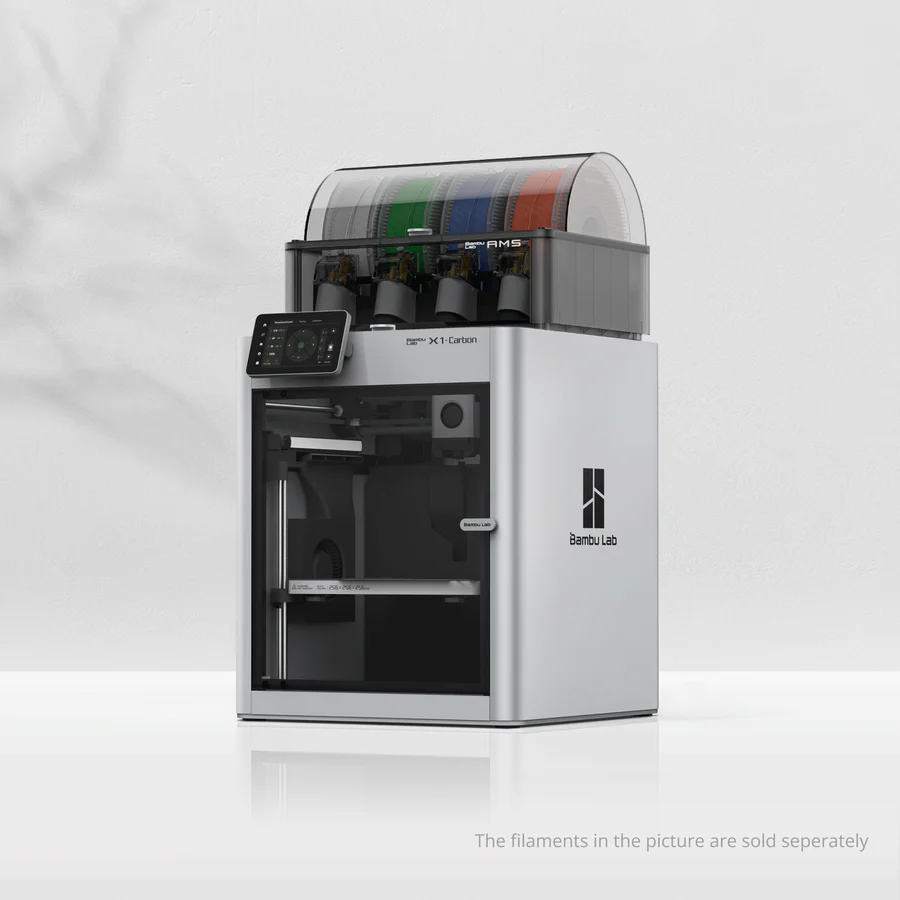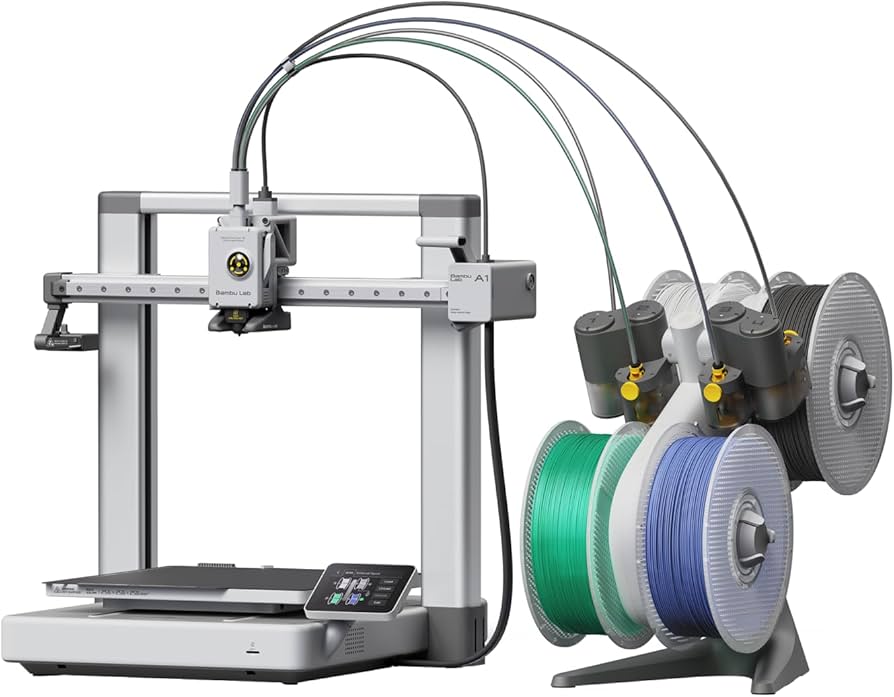Compare X1 carbon vs A1
Comparison between the best 3D printers
Choose the best 3D printer at the best price. The cheapest 3D printers are here.
Buy a 3D printer here with 3D Fila.
 |
 |
|
| Model | X1 carbon |
A1[BUY A1] |
| Printing Material | Filament | Filament |
| Buy Filament for Bambu Lab X1 carbon | Buy Filament forBambu Lab A1 | |
| Estimated price | $1449,00 | $700,00 |
| Manufacturer | Bambu Lab | Bambu Lab |
| Release Year | 2023 | 2023 |
| Print Volume [mm] | 256x256x256 | 256x256x256 |
| Printer Size [mm] | 389x389x457 | 385x410x430 |
| Weight [kg] | 14,13 | 8,3 |
| Power Loss Recovery | YES | YES |
| Enclosed printer | YES | NO |
| Bed Leveling | Automatic | Automatic |
| Filament End Sensor | YES | YES |
| Bed type | Heated | Heated |
| Power supply system | Direct Drive | Direct Drive |
| Standard nozzle | 0,4 | 0,4 |
| Maximum Nozzle Temperature [°C] | 300 | 300 |
| Maximum Bed Temperature [°C] | 120 | 100 |
| Maximum printing speed [mm/s] | 500 | 500 |
| Filament holder | YES | YES |
| Camera for supervision | YES | YES |
| Recommended filaments | PLA, PETG, TPU, PVA, PA, PA-CF, Nylon, PC | PLA, PETG, TPU, PVA |
| Recommended slicers | Bambu Studio, Super Slicer, Cura, Prusa Slicer, Orca | SuperSlicer, PrusaSlicer, Cura, OrcaSlicer |
| Maximum Resolution [mm] | 0,1 | 0,1 |
| Processor | Quad ARM A7 1.2 GHz | |
| Display | Touchscreen 5'' | Touchscreen 3,5 |
| Power Supply | 350 W | 350 W |
| Connectivity | Wifi, Bambu bus, Cartão SD | Wi-Fi, Bambu-Bus, Cartão Micro SD |
| Operating systems | Windows, Linux, Macbook | Windows, Linux, Macbook |
| Date of registration in the system | 2024-04-10 | 2024-07-17 |
| Release date | 2023 | 2023 |
| Extra features | The Bambu Lab X1 Carbon revolutionizes 3D printing with stunning design, high print speeds, and a streamlined user experience. It stands out with its CoreXY system, a hotend capable of reaching 300°C, allowing for a wide range of filaments. Its LiDAR-assisted bed leveling system, vibration compensation, and AMS multicolor printing capability raise the industry standard. Print quality is impressive, with the ability to fine-tune for perfection. The X1 Carbon, with its closed build volume, not only promises but also delivers one of the most advanced 3D printing experiences available to consumers. | The BambuLab A1 printer features fully automatic calibration, multi-color printing with the AMS system, active flow rate compensation, quick nozzle change with a clip, active motor noise cancellation, a build volume of 256x256x256 mm³, a maximum extruder temperature of 300°C, and a heated bed of up to 100°C. In addition, it has high precision, a machine health management system and an intuitive 3.5-inch touchscreen interface. |
| Support for multiple colors and materials (AMS and CFS) | YES | YES |
Notes * |
||
| Cost-benefit | 7 / 10 | 7 / 10 |
| Hardware | 6.4 / 10 | 4.8 / 10 |
| Tela | . | . |
| Print volume | 4 / 10 | 4 / 10 |
| Performance | 4 / 10 | 4 / 10 |
| [BUY A1] |
Conclusion |
| In comparing the Bambu Lab X1 Carbon and the Bambu Lab A1, several key factors emerge that can guide potential buyers in selecting the best 3D printer for their needs. **Price and Cost-Effectiveness**: The X1 Carbon, while significantly more expensive, offers advanced features suited for high-end users wanting an exceptional 3D printing experience. In contrast, the A1 provides excellent value for budget-conscious users, with a slightly better cost-benefit ratio considering its price point. **Build Quality and Features**: The X1 Carbon stands out due to its closed build environment, which can enhance print quality and safety while reducing noise. It also boasts advanced features such as LiDAR-assisted bed leveling and vibration compensation, making it suitable for demanding projects. The A1, although more basic, still offers fully automatic calibration, multi-color printing, and an intuitive interface, making it a solid choice for users who prioritize ease of use over high-end capabilities. **Performance and Print Quality**: Both printers share similar print volumes and maximum speeds, providing competitive performance despite their differences in construction and features. The X1 Carbon's advanced precision and technologies may provide a slight edge in demanding applications, while the A1 maintains good print quality suitable for general use. **Material Compatibility**: The X1 Carbon supports a broader range of materials due to its higher maximum bed temperature and more advanced heating capabilities. This can be a crucial factor for professionals looking to work with a variety of filaments. The A1, while less versatile, still handles essential materials effectively. **User Experience**: The X1 Carbon's larger touchscreen and additional features contribute to a more user-friendly interface. In comparison, the A1's smaller screen may be sufficient for its price but offers a more basic user interaction. In conclusion, the Bambu Lab X1 Carbon is an excellent choice for users willing to invest in a premium 3D printer with advanced features and exceptional performance, making it ideal for professionals and enthusiasts alike. Conversely, the Bambu Lab A1 provides a cost-effective and user-friendly option, appealing particularly to beginners and hobbyists looking for good performance without breaking the bank. Ultimately, the choice between the two should be guided by budget, intended use, and the level of advanced functionality desired. |

